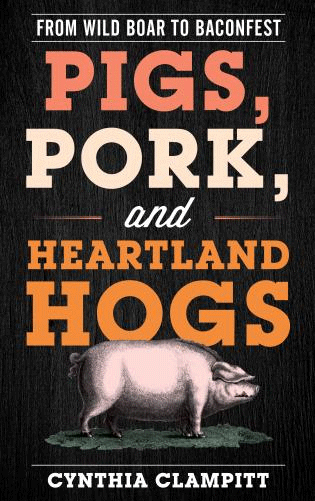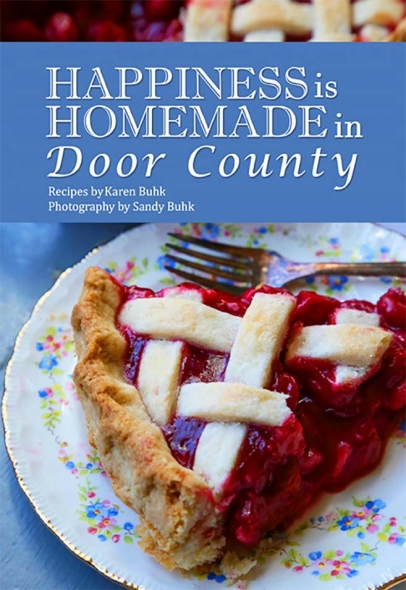Books for Cooks: Some Tasty Gift Ideas
There’s nothing like the drive from Madison to Washington Island to help you get through a reading list. I got caught up with mine by enjoying the following titles on a recent trip north (lucky for me, my husband likes to drive). All were published in 2018 and make fine holiday gifts for the foodies in your life.
HAPPINESS IS HOMEMADE IN DOOR COUNTY
by Karen Buhk
(HenschelHAUS Publishing Inc.)
Karen Buhk is known around these parts as the “Cookie Grandma.” A Door County resident for some 40 years, she got the nickname from a frequent recipient of her luscious, feel-good cooking and baking – her great grandson, Nathan.
Raised in rural Seymour, Wisconsin, Buhk learned how to cook the old-fashioned way – from her mother and grandmother, who didn’t just pass down their specialties but taught her how to look, feel and taste her way through recipes. The proof is in the pudding – or rather, in Buhk’s apple pie cake, cinnamon rolls and banana cream pie – in a handsome new hardcover filled with the delicacies and details she has mastered over a lifetime at the stove.
Cakes, cookies, pies and other sweets take center stage in Happiness is Homemade in Door County. Indeed, unlike most other cookbooks, dessert recipes come before the savory dishes in this book, and they highlight local favorites such as cream puffs, cherry pie and kolache.
The full-color, larger-than-life photos that accompany each recipe were supplied by photography instructor Sandy Buhk, who also happens to be Karen’s granddaughter. Family food stories lead off many of the pages, and a final chapter is devoted to large-group holiday cooking. Buhk weaves it all together with enthusiasm, expertise and best of all, love

KITCHEN CHAOS: RECIPES FROM A WISCONSIN HOMESTEAD
by Charlie Tennessen
(Anarchy Acres)
We hear a lot about heirloom crops like tomatoes and apples, but hard on the heels of their popularity today are heritage grains. One of the state’s biggest proponents and earliest growers of old-style grains is homesteader Charlie Tennessen, whose farm near Racine helps supply southeastern Wisconsin with tasty, nutritious and environment-friendly wheat. He also raises chickens and goats, grows organic vegetables, plows with donkeys (not machines), stone-grinds his own flint corn, and bakes his own brick-oven-baked bread.
An inspiration to anyone in the seed-to-table movement, Tennessen has now also produced a helpful guide for folks who want to participate more in their own food system. While self-sufficiency is a life philosophy for Tennessen, he also knows that a person can’t do everything, so his new cookbook is more road map than manual. Both ingredients and directions are simple and straightforward, but with plenty of room to play, in dishes such as veggie-loaded scrambled eggs, corn grits with maple syrup and melted butter, wheat-berry tabbouleh, and sourdough bread toasted in bacon fat.
“I have tried to create a life where I will eat good food as a matter of course,” writes Tennessen. “What’s most important is that you try.”

PIGS, PORK AND HEARTLAND HOGS: FROM WILD BOAR TO BACON FEST
by Cynthia Clampitt
(Rowman & Littlefield)
As a longtime member of an organization called the Culinary History Enthusiasts of Wisconsin (CHEW), I’m a fan of one of its frequent speakers, Cynthia Clampitt, a Chicago- based food historian and author whose specialty is the American Midwest. I learned so much from her book, Midwest Maize: How Corn Shaped the U.S. Heartland, and now she has a new book out that is the perfect companion to it: Pigs, Pork and Heartland Hogs. The most commonly eaten meat in the world, pork has special significance in our region, where more of it is produced than anywhere else. Where corn went, pigs followed, says Clampitt, as she tells the story of how “‘hogs and hominy’ became anaphorism for an American agricultural paradigm and the abundance it produced.”
But the pig’s historical and cultural significance goes much further, too, reaching back to prehistory and stretching across the globe. Clampitt’s enjoyable and thoroughly researched study explores everything from how wild boars became domesticated to the farm-to-table resurgence of interest in pork today. And yes, there are recipes, including Wisconsin small-town favorites like Scandinavian ham balls and split pea soup.






